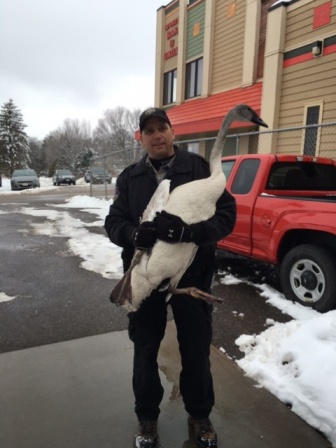Local News
No Swan Song For This Trumpeter

When the citizens of Barron County’s Cumberland first spotted the large bird just standing on the ice, they knew who to call – DNR Conservation Warden Phil Dorn.
Warden Phil, on the job in Wisconsin’s northwest area since 1992, says some of the citizens concerned about the injured bird thought it was a goose.
Out on calls already that January day, he kept his eyes peeled for a goose. But, it wasn’t a goose. Then, he saw it. Yes, it was big, but it wasn’t a goose.
“I found it standing on the ice on the little lake in downtown Cumberland,” Warden Phil said of the highly unusual sight of a trumpeter swan parked on the ice the afternoon of Friday, January 8. What it was doing there was anybody’s guess at this point. Warden Phil had his.
“This bird may have just kept swimming down the chain of lakes until he got to Beaver Dam Lake – the last lake to freeze over in Barron County.”
Whatever the reason, Warden Phil knew he had to do his best swan shuffle to get it, so he could help it. Thinking ahead of the worst possible scenario – as if running on ice in work boots is not bad enough — Warden Phil got the assistance of a Cumberland police officer and asked him to be positioned on the road nearby. That was in case the bird opted for a sudden directional change, resulting in the mad dash into traffic.
“But, I got it to run the other way,” Warden Phil said, meaning away from the road. That also meant Warden Phil utilized his 100-yard dash running skills for a couple of hundred yards across the ice. The bird attempted to fly but it just couldn’t lift itself. “It just got tired right away. It likely wasn’t getting great nutrition and it was cold.”
Warden Phil was able to gently grab the big bird, described by the U.S. Fish and Wildlife Service as a majestic bird known as the largest swan in the world and the largest waterfowl in North America. As you can see in the photo, the swan’s mass rivals Warden Phil’s. How much does that bird weigh? “About 15 pounds,” he said.
A local volunteer offered to drive the injured swan to the Wildlife Rehabilitation Center of Minnesota in the Minneapolis-St. Paul metropolitan area. The center last year cared for a record of nearly 12,000 birds, reptiles and mammals from Minnesota and Wisconsin. Communications Director Tami Vogel says that’s a leap of 30 percent from 2014 for the center which operates on private funds and donations.
The swan rescued in Cumberland joined 6 other such majestic swans in this animal hospital in neighboring Minnesota. Once in the care of these wildlife experts, the swan was examined and the veterinarians and rehabilitators learned why this bird hadn’t left beautiful Cumberland long ago. “It’s the primary feathers that are in such bad shape,” Vogel said.
And that’s why it couldn’t fly.
Plus, the bird has open wounds and frostbite on its feet. As the swan heals, the veterinarians will determine the best treatment to get this swan back doing swan-like things in the wild. For now, Vogel reports the swan is healing, thanks to concerned citizens, Warden Phil and the pros at the Wildlife Rehabilitation Center of Minnesota.
Warden Phil says the citizens did the right thing by contacting the DNR about the bird. Contacting a licensed wildlife rehabilitator is another good idea if citizens are concerned an animal needs assistance. Wild animals are valued by many, and it’s important to observe them at a respectful distance to keep them wild and allow for their life in the wild to continue. Or, in this case, alert the professionals to go and observe the animal from a distance and decide the best course of action!
The jump in the Minnesota center’s patient load reflects more and more people concerned about wildlife. And for Warden Dorn, citizens’ concern about their wildlife neighbors is business as usual in northern Wisconsin
“I get a lot of calls about wildlife,” Warden Phil says. “I think every warden does.”
And that’s no swan song.


